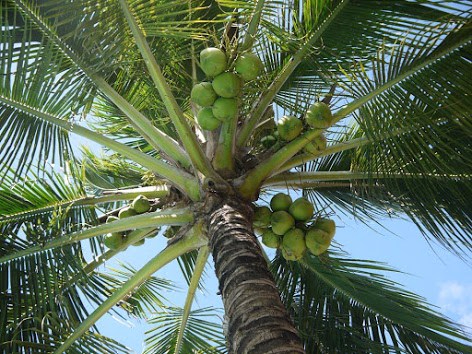 Cocos nucifera. Coconut palms are grown widely in coastal area’s. Copra, the dried kernel is the chief commercial product from coconut, which is mainly used for oil extraction. Copra normally has an oil content varying from 65 to 72 per cent. The skin or coir is used as a fuel, as potting soil and as filter material for bio-filters.
Cocos nucifera. Coconut palms are grown widely in coastal area’s. Copra, the dried kernel is the chief commercial product from coconut, which is mainly used for oil extraction. Copra normally has an oil content varying from 65 to 72 per cent. The skin or coir is used as a fuel, as potting soil and as filter material for bio-filters.
Coconut oil is a fat consisting of about 90% saturated fat. The oil contains predominantly medium chain triglycerides, with roughly 92% saturated fatty acids, 6% monounsaturated fatty acids, and 2% polyunsaturated fatty acids. Of the saturated fatty acids, coconut oil is primarily 44.6% lauric acid, 16.8% myristic acid , 8.2% palmitic acid and 8% caprylic acid. Although it contains seven different saturated fatty acids in total, its only monounsaturated fatty acid is oleic acid while its only polyunsaturated fatty acid is linoleic acid.
In the human body lauric acid is converted into monolaurin. [3]
Unrefined coconut oil melts at 24-25°C (76°F) and smokes at 177°C (350°F),[4] while refined coconut oil has a higher smoke point of 232°C (450°F).
Among the most stable of all oils, coconut oil is slow to oxidize and thus resistant to rancidity, lasting up to two years due to its high saturated fat content. [5] In order to extend shelf life, it is best stored in solid form (i.e. below 24.5°C [76°F]).
